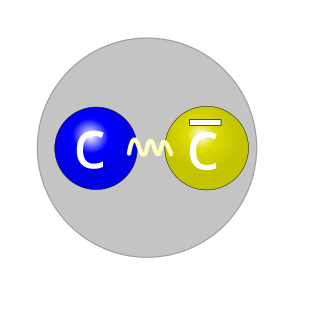Related Research Articles

A black hole is a region of spacetime where gravity is so strong that nothing, not even light and other electromagnetic waves, is capable of possessing enough energy to escape it. Einstein's theory of general relativity predicts that a sufficiently compact mass can deform spacetime to form a black hole. The boundary of no escape is called the event horizon. A black hole has a great effect on the fate and circumstances of an object crossing it, but it has no locally detectable features according to general relativity. In many ways, a black hole acts like an ideal black body, as it reflects no light. Quantum field theory in curved spacetime predicts that event horizons emit Hawking radiation, with the same spectrum as a black body of a temperature inversely proportional to its mass. This temperature is of the order of billionths of a kelvin for stellar black holes, making it essentially impossible to observe directly.
The following is a timeline of gravitational physics and general relativity.
Hawking radiation is the theoretical thermal black-body radiation released outside a black hole's event horizon. This is counterintuitive because once ordinary electromagnetic radiation is inside the event horizon, it cannot escape. It is named after the physicist Stephen Hawking, who developed a theoretical argument for its existence in 1974. Hawking radiation is predicted to be extremely faint and is many orders of magnitude below the current best telescopes' detecting ability.
The no-hair theorem states that all stationary black hole solutions of the Einstein–Maxwell equations of gravitation and electromagnetism in general relativity can be completely characterized by only three independent externally observable classical parameters: mass, electric charge, and angular momentum. Other characteristics are uniquely determined by these three parameters, and all other information about the matter that formed a black hole or is falling into it "disappears" behind the black-hole event horizon and is therefore permanently inaccessible to external observers after the black hole "settles down". Physicist John Archibald Wheeler expressed this idea with the phrase "black holes have no hair", which was the origin of the name.

The charm quark, charmed quark, or c quark is an elementary particle found in composite subatomic particles called hadrons such as the J/psi meson and the charmed baryons created in particle accelerator collisions. Several bosons, including the W and Z bosons and the Higgs boson, can decay into charm quarks. All charm quarks carry charm, a quantum number. This second generation particle is the third-most-massive quark with a mass of 1.27±0.02 GeV/c2 as measured in 2022 and a charge of +2/3 e.

Samuel Chao Chung Ting is an American physicist who, with Burton Richter, received the Nobel Prize in 1976 for discovering the subatomic J/ψ particle.

In physics, black hole thermodynamics is the area of study that seeks to reconcile the laws of thermodynamics with the existence of black hole event horizons. As the study of the statistical mechanics of black-body radiation led to the development of the theory of quantum mechanics, the effort to understand the statistical mechanics of black holes has had a deep impact upon the understanding of quantum gravity, leading to the formulation of the holographic principle.
The Immirzi parameter is a numerical coefficient appearing in loop quantum gravity (LQG), a nonperturbative theory of quantum gravity. The Immirzi parameter measures the size of the quantum of area in Planck units. As a result, its value is currently fixed by matching the semiclassical black hole entropy, as calculated by Stephen Hawking, and the counting of microstates in loop quantum gravity.
Micro black holes, also called mini black holes or quantum mechanical black holes, are hypothetical tiny black holes, for which quantum mechanical effects play an important role. The concept that black holes may exist that are smaller than stellar mass was introduced in 1971 by Stephen Hawking.

The
J/ψ
(J/psi) meson is a subatomic particle, a flavor-neutral meson consisting of a charm quark and a charm antiquark. Mesons formed by a bound state of a charm quark and a charm anti-quark are generally known as "charmonium" or psions. The
J/ψ
is the most common form of charmonium, due to its spin of 1 and its low rest mass. The
J/ψ
has a rest mass of 3.0969 GeV/c2, just above that of the
η
c, and a mean lifetime of 7.2×10−21 s. This lifetime was about a thousand times longer than expected.

Brandon Carter, is an Australian theoretical physicist who explores the properties of black holes, and was the first to name and employ the anthropic principle in its contemporary form. He is a researcher at the Meudon campus of the Laboratoire Univers et Théories, part of the French CNRS.
James W. York Jr. was an American mathematical physicist who contributed to the theory of general relativity. In any physical theory, it is important to understand when solutions to the fundamental field equation exist, and answering this question was a theme of York's scientific work, with Yvonne Choquet-Bruhat, of formulating the Einstein field equation as a well-posed system in the sense of the theory of partial differential equations.
This is a timeline of subatomic particle discoveries, including all particles thus far discovered which appear to be elementary given the best available evidence. It also includes the discovery of composite particles and antiparticles that were of particular historical importance.

In materials science, an interstitial defect is a type of point crystallographic defect where an atom of the same or of a different type, occupies an interstitial site in the crystal structure. When the atom is of the same type as those already present they are known as a self-interstitial defect. Alternatively, small atoms in some crystals may occupy interstitial sites, such as hydrogen in palladium. Interstitials can be produced by bombarding a crystal with elementary particles having energy above the displacement threshold for that crystal, but they may also exist in small concentrations in thermodynamic equilibrium. The presence of interstitial defects can modify the physical and chemical properties of a material.

In cosmology, primordial black holes (PBHs) are hypothetical black holes that formed soon after the Big Bang. In the inflationary era and early radiation-dominated universe, extremely dense pockets of subatomic matter may have been tightly packed to the point of gravitational collapse, creating primordial black holes without the supernova compression typically needed to make black holes today. Because the creation of primordial black holes would pre-date the first stars, they are not limited to the narrow mass range of stellar black holes.
A black hole firewall is a hypothetical phenomenon where an observer falling into a black hole encounters high-energy quanta at the event horizon. The "firewall" phenomenon was proposed in 2012 by physicists Ahmed Almheiri, Donald Marolf, Joseph Polchinski, and James Sully as a possible solution to an apparent inconsistency in black hole complementarity. The proposal is sometimes referred to as the AMPS firewall, an acronym for the names of the authors of the 2012 paper. The potential inconsistency pointed out by AMPS had been pointed out earlier by Samir Mathur who used the argument in favour of the fuzzball proposal. The use of a firewall to resolve this inconsistency remains controversial, with physicists divided as to the solution to the paradox.

Luigi Di Lella is an Italian experimental particle physicist. He has been a staff member at CERN for over 40 years, and has played an important role in major experiments at CERN such as CAST and UA2. From 1986 to 1990 he acted as spokesperson for the UA2 Collaboration, which, together with the UA1 Collaboration, discovered the W and Z bosons in 1983.
Stephen Albert Fulling is an American mathematician and mathematical physicist, specializing in the mathematics of quantum theory, general relativity, and the spectral and asymptotic theory of differential operators. He is known for preliminary work that led to the discovery of the hypothetical Unruh effect.
Alan Harold Luther is an American physicist, specializing in condensed matter physics.
References
- ↑ Melia, Fulvio (2007). The Galactic Supermassive Black Hole. Princeton University Press. p. 2. ISBN 978-0-691-13129-0.
- ↑ Hawking, S. W. (1974-03-01). "Black hole explosions?". Nature . 248 (5443): 30. Bibcode:1974Natur.248...30H. doi:10.1038/248030a0. S2CID 4290107.
- ↑ Hellegouarch, Yves (1974). "Points d'ordre 2ph sur les courbes elliptiques" (PDF). Acta Arithmetica. 26 (3). Polska Akademia Nauk. Instytut Matematyczny: 253–263. doi: 10.4064/aa-26-3-253-263 . ISSN 0065-1036. MR 0379507.
- ↑ "About the Cochrane Library". The Cochrane Library. Archived from the original on 2011-01-05. Retrieved 2011-01-25.
- ↑ Heimlich, H. (June 1974). "Pop Goes the Cafe Coronary". Emergency Medicine.
- ↑ "India's Nuclear Weapons Program – Smiling Buddha: 1974". Nuclear Weapon Archive. 2001. Archived from the original on 19 May 2011. Retrieved 2011-05-25.
- ↑ Aubert, J. J.; et al. (2 December 1974). "Experimental Observation of a Heavy Particle J". Physical Review Letters. 33 (23): 1404–6. Bibcode:1974PhRvL..33.1404A. doi: 10.1103/PhysRevLett.33.1404 .
- ↑ Augustin, J.-E.; et al. (2 December 1974). "Discovery of a Narrow Resonance in e+e− Annihilation". Physical Review Letters . 33 (23): 1406–8. Bibcode:1974PhRvL..33.1406A. doi: 10.1103/PhysRevLett.33.1406 .
- ↑ Gillie, O. (1976-10-24). "Crucial data was faked by eminent psychologist". The Sunday Times . London.
- ↑ Kleinman, Zoe (2012-10-07). "Barcode birthday: 60 years since patent". BBC News . Retrieved 2013-06-29.
- ↑ Fotheringham, William (2007). Fotheringham's Sporting Pastimes. Anova Books. p. 50. ISBN 978-1-86105-953-6.
- ↑ "6 Women Scientists Who Were Snubbed Due to Sexism". National Geographic News. 19 May 2013. Archived from the original on September 3, 2019. Retrieved 19 January 2021.